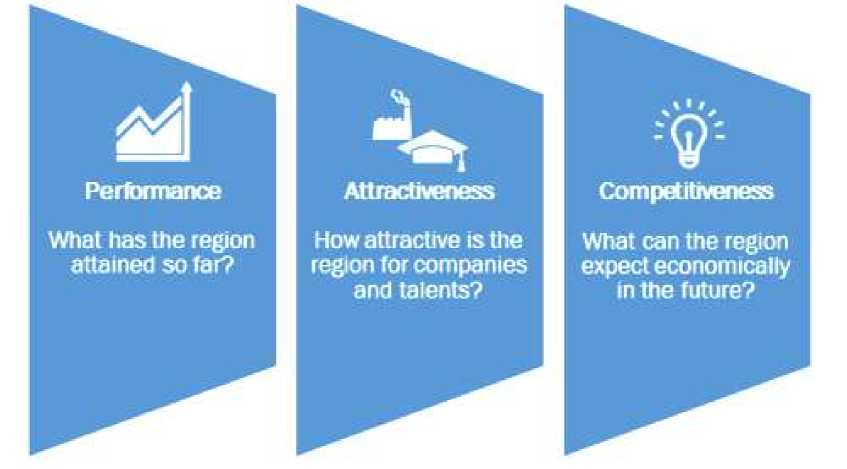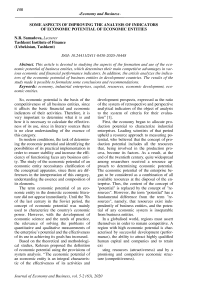Some aspects of improving the analysis of indicators of economic potential of economic entities
Автор: Samadova N.R.
Журнал: Экономика и бизнес: теория и практика @economyandbusiness
Статья в выпуске: 5-2 (63), 2020 года.
Бесплатный доступ
This article is devoted to studying the aspects of the formation and use of the economic potential of business entities, which determines their main competitive advantages in various economic and financial performance indicators. In addition, the article analyzes the indicators of the economic potential of business entities in development countries. The results of the study made it possible to formulate some conclusions and recommendations.
Economy, industrial enterprises, capital, resources, economic development, economic entities
Короткий адрес: https://sciup.org/170182720
IDR: 170182720 | DOI: 10.24411/2411-0450-2020-10448
Текст научной статьи Some aspects of improving the analysis of indicators of economic potential of economic entities
So, economic potential is the basis of the competitiveness of all business entities, since it affects the basic financial and economic indicators of their activities. Therefore, it is very important to determine what it is and how it is necessary to calculate the effectiveness of its use, since in literary sources there is no clear understanding of the essence of this category.
In modern conditions, the task of determining the economic potential and identifying the possibilities of its practical implementation in order to ensure stability and increase the efficiency of functioning faces any business entity. The study of the economic potential of an economic entity necessitates clarification of the conceptual apparatus, since there are differences in the interpretation of this category, understanding the essence and composition of its elements.
The term economic potential of an economic entity in the domestic economic literature did not appear immediately. Until the 70s of the last century in the Soviet period, the concept of economic potential was mainly used to characterize the country's economic power. However, with the development of economic science and the needs of practice, the relevance of solving the problems of quantitative and qualitative measurements of the enterprise’s potential and the effectiveness of its use in achieving its goals has increased.
Based on the theoretical and methodological studies, Kolesen proposed the definition of economic potential using the provisions of system analysis. “The economic potential of an economic entity is an integral characteristic of the effectiveness of its activities and development prospects, expressed as the ratio of the system of retrospective and perspective analytical indicators of the object of analysis to the system of criteria for their evaluation” [1].
First, the economy began to allocate production potential to characterize industrial enterprises. Leading scientists of that period upheld a resource approach to measuring potential, who believed that the concept of production potential includes all the resources that, being involved in the production process, become its factors. As a result, at the end of the twentieth century. quite widespread among researchers received a resource approach to determining economic potential. The economic potential of the enterprise began to be considered as a combination of all available resources at the disposal of the enterprise. Thus, the content of the concept of "potential" is replaced by the concept of "resources". However, the term "potential" has a fundamental difference from the term "resources", namely, that resources exist independently of business entities, and the potential of any economic system is inseparable from business entities.
In a globalised world, regions must assert themselves in order to remain competitive. A region with high economic potential is characterised by successful development (performance), the ability to attract highly qualified human capital and companies and to retain exi sting resources (attractiveness) and by a promising and competitive economic structure (competitiveness).

Based on these three core areas, Economics has created the Economic Potential Index, which allows an international comparison of your region's economic potential using 26 comprehensive indicators and is composed as follows [2]:
– Measurement of economic success on the basis of previous economic development;
– Demonstrating the attractiveness of your region for companies and highly qualified employees;
– Identification of the future competitiveness and thus the future economic development of your region.
Under the potential is usually understood opportunities, abilities, hidden and unrealized reserves, which under certain conditions can go from opportunity to reality. On this basis, most researchers in recent years interpret the economic potential from the perspective of the ability of an economic entity to develop and efficiently use available resources. Also, the economic potential is considered from the point of view of reserves to improve the production and economic activities of an economic entity. However, it is necessary to distinguish between the concepts of “potential” and “reserves”. The "potential" reflects both the existing and the possible (potential), and in the "reserves" – only the possible, unused. Thus, the reserves used are an essential, but not the only part of the economic potential. Unused opportunities appear in the form of production reserves, which ultimately reflect the degree of use of economic potential.
The economic potential of an economic entity acts as a complex system, the main elements of which are local potentials (subsystems). Local potentials are interconnected and collectively determine the state of the entire system. Despite the availability of a sufficient number of publications, there is no comprehensive and clear idea of the structure of the economic potential of an economic entity. In the economic literature, the quantitative composition of the proposed local potentials varies significantly – from two to ten; there are suggestions for the need to take into account additional conditions and factors.
In the structure of economic potential, researchers distinguish production, labor, financial, resource, organizational and managerial, market, innovative and other potentials. Consideration of the economic potential from different perspectives has led to a variety of methodological approaches to assessing the economic potential of an economic entity.
Assessment of economic potential cannot be based on an arbitrary set of indicators. Therefore, the selection and justification of the initial indicators of financial and economic activity should be carried out in accordance with the ideas of the organization’s finance theory, based on the goals of the assessment, the needs of management entities in the analytical assessment.
This system of indicators, proposed and recommended by Sheremet and Saifulin, is based on public reporting data of the enterprise, which provides a mass assessment of enterprises, allows all interested user groups to monitor changes in the financial condition of organizations [3].
Having studied and summarized the studies regarding the essence of the concept of “economic potential”, we propose to clarify this definition: economic potential is the capacity of an economic entity, taking into account its resources in conditions of uncertainty and high competition in order to implement strategic priorities for the development of an economic entity.
It should be noted that in practice, assessing the economic potential of an econom- ic entity and its structural elements, taking into account their characteristics, is quite problematic. Therefore, when determining the magnitude of the economic potential, there are a number of restrictions and conditions: it is impossible to measure economic potential with any single indicator; when forming a system of basic indicators, only those that are available in various types of reporting of an economic entity are subject to final selection; it is necessary to take into account industry characteristics of the business entity; deliberate simplification of the technique is permissible, since the result of the calculation should be expressed not in absolute but in relative terms.
Список литературы Some aspects of improving the analysis of indicators of economic potential of economic entities
- Kolesen E.V. Improving the methodology for analyzing the economic potential of an economic entity. Abstract of dissertation for the degree of candidate of economic sciences. - Samara 2012. - 21 p.
- [Electronic resource]. Access mode: https://rea.bak-economics.com/en/services/economic-potential-index
- Sheremet A.D. Methods of financial analysis of the enterprise // A.D. Sheremet, R.S. Sayfullin, E.V. Negashev. - M.: INFRA-M, 2006. - 208 p.


